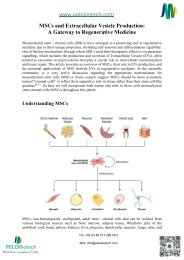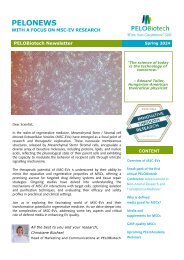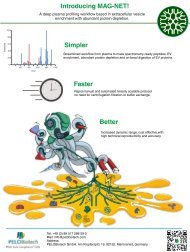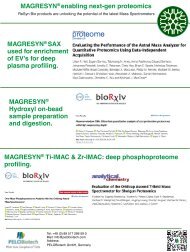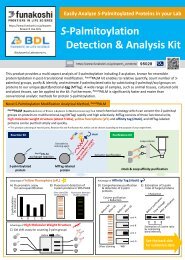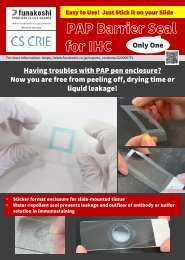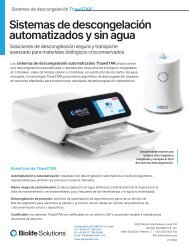GolgiSeeing
GolgiSeeing is a novel and innovative fluorescent dye for selective Golgi apparatus staining. Compared to conventional ceramide-based Golgi staining reagents, GolgiSeeing does not require complicated procedures and suppresses non-specific localization to the endoplasmic reticulum.
GolgiSeeing is a novel and innovative fluorescent dye for selective Golgi apparatus staining. Compared to conventional ceramide-based Golgi staining reagents, GolgiSeeing does not require complicated procedures and suppresses non-specific localization to the endoplasmic reticulum.
You also want an ePaper? Increase the reach of your titles
YUMPU automatically turns print PDFs into web optimized ePapers that Google loves.
Distributed by PELOBIOTECH GmbH<br />
(P) +49 89 517 286 59-0<br />
(F) +49 89 517 286 59-88<br />
Email: info@pelobiotech.com<br />
www.pelobiotech.com<br />
<strong>GolgiSeeing</strong> <br />
Catalog NO. FDV-0053<br />
Research use only, not for human or animal therapeutic or diagnostic use.<br />
This product has been commercialized under a license from the Nagoya Institute of Technology<br />
Product Background<br />
The Golgi apparatus is an organelle that plays various roles in physiological functions and is known as a central<br />
component of the protein secretory pathway. The Golgi apparatus has unique multiple-layered cisternal membrane<br />
structures, with subdivided structures such as cis-Golgi, which is responsible for reciprocal vesicular transport with<br />
the endoplasmic reticulum (ER), and trans-Golgi, which is the starting point of the secretory pathway. Since dynamic<br />
morphological changes of the Golgi apparatus are essential for secretory function and dysfunction of the Golgi<br />
apparatus has been implicated in a number of diseases, it is expected that the Golgi apparatus will be observed by<br />
live cell imaging.<br />
Two major methods have been used to stain the Golgi apparatus in living cells: The first is fluorescent staining<br />
using fluorescently labeled ceramide derivatives (hereafter ceramide-FL). Ceramide lipids accumulate in the Golgi<br />
apparatus during the metabolic pathway, and ceramide-FLs have been used to visualize the Golgi apparatus. However,<br />
1) The Golgi selectivity of ceramide derivatives is low, 2) Ceramide derivatives also localize to the ER, etc., and 3)<br />
Ceramide derivatives have high cytotoxicity and are quickly metabolized intracellularly. The second staining method<br />
is to overexpress fluorescent proteins by fusing them to Golgi-specific expressed proteins (such as Giantin, N-<br />
acetylgalactosaminyltransferase, etc.). While this method allows visualization of the Golgi apparatus with a high<br />
degree of specificity, it requires prior plasmid transfection, making it impossible to immediately observe the Golgi<br />
apparatus when necessary. Furthermore, there are concerns overexpression of specific marker genes may affect<br />
physiological functions of the Golgi apparatus. <strong>GolgiSeeing</strong> is a novel small molecule fluorescent reagent that utilizes<br />
a Golgi apparatus selective localization motif discovered by Dr. Shinya Tsukiji's group at Nagoya Institute of<br />
Technology. Unlike conventional ceramide-FLs, it can stain the Golgi apparatus with a simple protocol that requires<br />
only 10 minutes of addition to the culture medium. It also shows higher Golgi specificity than ceramide-FLs, allowing<br />
Golgi apparatus-focused analysis (Figure 1). The <strong>GolgiSeeing</strong> can visualize the Golgi apparatus of target cells at any<br />
desired timing without genetic manipulation and without bias to physiological functions caused by overexpression,<br />
allowing the dynamic behavior of the Golgi apparatus to be observed under more physiological conditions. Under<br />
the non-wash protocol, <strong>GolgiSeeing</strong> visualizes not only the Golgi apparatus but also the plasma membrane. This<br />
property allows simultaneous imaging of the Golgi apparatus and cell morphology (judged by plasma membrane).<br />
Figure 1. Overview image of <strong>GolgiSeeing</strong>
<strong>GolgiSeeing</strong> (original compound name; mgc 3Me FDA in Ref.1) has a unique structure consisting of fluorescein<br />
diacetate (FDA) and N-myristoylated Gly-Cys dipeptide (mgc) linked by a linker, and three amide bonds in the mgc<br />
peptide chain are all methylated (Figure 2 left, upper). <strong>GolgiSeeing</strong> functions as a Golgi apparatus-selective<br />
fluorescent probe through several processes in the cell. FDA is a modified fluorescein quenched to improve cell<br />
membrane permeability, and <strong>GolgiSeeing</strong> emits slight fluorescence before use. After <strong>GolgiSeeing</strong> penetrates the cell<br />
membrane and enters the cell, acetyl groups are removed by endogenous esterases, and the green fluorescence of<br />
fluorescein is restored (Figure 2 left, middle). The deacetylated form of <strong>GolgiSeeing</strong> transiently localizes mainly to<br />
the ER and Golgi apparatus by the effect of N-myristoyl groups and is S-palmitoylation by endogenous S-<br />
palmitoylation enzymes. The Golgi apparatus selective localization motif is formed by adding palmitic acid to the<br />
Cys side chain by enzymatic action (Figure 2 left, lower). Although the intrinsic palmitoylation modification is<br />
known to localize to the Golgi apparatus and the plasma membrane, the effect of the three methyl groups biases the<br />
equilibrium toward the Golgi, which allows <strong>GolgiSeeing</strong> to selectively visualize the Golgi apparatus (Figure 2 right).<br />
Figure 2. Principle of <strong>GolgiSeeing</strong><br />
Table Live cell Golgi apparatus imaging methods<br />
Category Genetically encoded Fluorescent probes<br />
Staining<br />
Fluorescent protein-fused Golgi<br />
apparatus marker proteins<br />
Fluorescent-labeled ceramide<br />
derivatives (Ceramide-FL)<br />
Golgi apparatus specificity High Low<br />
(High ER background)<br />
Protocol<br />
Easy<br />
Complicated<br />
(Exogenous gene transfection) (Require stepwise and<br />
temperature-controlled protocol)<br />
Time<br />
> half day<br />
(time for protein expression)<br />
Influence on physiological<br />
function<br />
High<br />
(Overexpression of exogenous<br />
proteins)<br />
<strong>GolgiSeeing</strong><br />
>1 hour 10 min<br />
High<br />
(Exogenous ceramide’s toxicity)<br />
High<br />
(Low ER background)<br />
Easy<br />
(Just addition to medium)<br />
Low<br />
[ver. 2023/08] Download the latest datasheet from www.funakoshi.co.jp (Japanese)<br />
www.funakoshi.co.jp/exports (English)
Description<br />
Catalog Number: FDV-0053<br />
Size: 0.1 mg<br />
Molecular weight: 1258.5 g/mol<br />
Solubility: Soluble in DMSO<br />
Fluorescent characteristics:<br />
Ex. 440-500 nm (maximum ~480 nm) / Em 500-560 nm (maximum ~520 nm)<br />
Compatible with conventional FITC filter set<br />
*NOTE: <strong>GolgiSeeing</strong> has fluorescein diacetate (FDA), which is quenched by two acetates and emits a slight<br />
fluorescence. After hydrolysis of two acetic groups in cells by physiological esterases, fluorescein<br />
is exposed and restores strong green fluorescence.<br />
Reconstitution and Storage<br />
Reconstitution: Stock solution recommended concentration 1 mM in 100% DMSO. Add 79 L of DMSO/vial to<br />
prepare 1 mM stock solution.<br />
Storage (powder): Store powder at less than -20 o C<br />
Storage (solution): After reconstitution in DMSO, aliquot and store at less than -20°C.<br />
Avoid repeated freeze-thaw cycles and recommend single use of each aliquot.<br />
Important notice for stability<br />
<strong>GolgiSeeing</strong> has a free-thiol group (See Figure 2 left), which is S-palmitoylated in cells and essential for Golgi<br />
apparatus localization. This thiol group is easily oxidized to form a homodimer in physiological pH buffers, and<br />
<strong>GolgiSeeing</strong>-dimer loses its Golgi apparatus localization function and may cause a background signal.<br />
<strong>GolgiSeeing</strong> working solution (such as <strong>GolgiSeeing</strong>-containing medium or buffers) should be prepared just<br />
before use. Importantly, <strong>GolgiSeeing</strong> may be gradually oxidized even in DMSO. After reconstitution of<br />
<strong>GolgiSeeing</strong> in DMSO, use within one month to maintain good staining results.<br />
How to use<br />
General procedure for Golgi apparatus-selective staining in live cells<br />
*This procedure is an example of Golgi apparatus-selective staining<br />
1. Prepare 10 M <strong>GolgiSeeing</strong> in serum-free medium such as DMEM just before use<br />
NOTE: Empirically optimize and determine the concentration of <strong>GolgiSeeing</strong> for your experiments.<br />
2. Remove the culture medium and wash cells with medium several times<br />
3. Add <strong>GolgiSeeing</strong>-containing medium to cells<br />
NOTE: Working solution of <strong>GolgiSeeing</strong> prepared in step-1 should be quickly used, as <strong>GolgiSeeing</strong> may be<br />
oxidazed to form inactive dimer in medium.<br />
4. Incubate cells at RT for 10 min<br />
NOTE: Empirically optimize incubation time and temperature for your experiments.<br />
5. Wash cells with 3 mg/ml BSA-containing medium over two times and add fresh serum-free and phenol redfree<br />
medium<br />
NOTE: <strong>GolgiSeeing</strong> is a highly hydrophobic compound and non-specifically absorbed to plastic or glass<br />
surface of imaging chambers. This non-specific absorption may cause the background signal of<br />
fluorescent images. To reduce non-specific signals, we highly recommend using a wash buffer<br />
containing BSA because BSA efficiently binds to excess <strong>GolgiSeeing</strong> and removes it from the surface<br />
of imaging chambers. 3 mg/ml BSA-containing basal medium is the preferred choice of <strong>GolgiSeeing</strong>wash<br />
buffer.<br />
6. Observe cells under live cell condition
General procedure for Golgi apparatus and plasma membrane staining in live cells<br />
*This procedure is an example of Golgi apparatus and plasma membrane staining<br />
1. Prepare 2 M <strong>GolgiSeeing</strong> in serum-free and phenol red-free medium such as DMEM just before use<br />
NOTE: Empirically optimize and determine the concentration of <strong>GolgiSeeing</strong> for your experiments.<br />
2. Remove the culture medium and wash cells with medium several times<br />
3. Add <strong>GolgiSeeing</strong>-containing medium to cells<br />
NOTE: Working solution of <strong>GolgiSeeing</strong> prepared in step-1 should be quickly used, as <strong>GolgiSeeing</strong> may be<br />
oxidazed to form inactive dimer in medium.<br />
4. Incubate cells at RT for 10 min<br />
NOTE: Empirically optimize incubation time temperature for your experiments.<br />
6. Observe cells without wash-out step under live cell condition<br />
Important Notice of Use<br />
1) <strong>GolgiSeeing</strong> will selectively localize to the Golgi apparatus through the S-palmitoylation on the free-thiol group<br />
by endogenous S-palmitoylation enzymes, as mentioned in Figure 2. Note that any drugs inhibiting S-<br />
palmitoylation may influence the Golgi apparatus-selective staining property of <strong>GolgiSeeing</strong>. Especially,<br />
alkylation reagents of the free thiol (such as maleimide, iodoacetate, etc.) will critically inhibit S-palmitoylation<br />
and are incompatible with <strong>GolgiSeeing</strong>.<br />
2) <strong>GolgiSeeing</strong> has no fixable functional groups in the molecule and is not fixed by either paraformaldehyde<br />
(PFA) or methanol. <strong>GolgiSeeing</strong> is a specialized reagent for live cell imaging applications, not compatible with<br />
fixed cell imaging and immunocytochemistry.<br />
3) Long incubation time of <strong>GolgiSeeing</strong> may increase ER-derived fluorescent signal and reduce Golgi/ER ratio.<br />
Conduct empirical optimization ranges for your experiments' incubation time and observation time course.<br />
Reference data<br />
Comparison between <strong>GolgiSeeing</strong> and a ceramide-based reagent<br />
HeLa cells were treated with 10 M <strong>GolgiSeeing</strong> or 5 M ceramide-FL (as BSA complex). In the case of <strong>GolgiSeeing</strong>,<br />
the protocol is a simple addition of <strong>GolgiSeeing</strong> into media final 10 M and incubated for 10 min. After washing<br />
cells with 3 mg/ml BSA containing media, fluorescent images were captured by confocal laser microscopy (Ex 488<br />
nm/Em 500-600 nm). On the other hand, ceramide-FL<br />
(BSA complex) -staining was performed by two<br />
protocols, simple addition or stepwise temperaturecontrolled<br />
protocol. The later protocol cells were<br />
incubated with ceramide-FL (BSA complex) for 30 min<br />
at 4 o C in HBSS, washed with ice-cold HBSS, and<br />
incubated in a fresh culture medium for an additional<br />
30 min at 37 o C. Finally, cells were washed with a fresh<br />
medium again and observed by confocal laser<br />
microscopy. This stepwise protocol requires over 1<br />
hour. The ceramide-FL probe stains not only the Golgi<br />
apparatus but also ER structure with high intensity nonspecifically.<br />
<strong>GolgiSeeing</strong> was able to visualize Golgi<br />
apparatus selectively and suppressed non-specific ER<br />
staining.<br />
[ver. 2023/08] Download the latest datasheet from www.funakoshi.co.jp (Japanese)<br />
www.funakoshi.co.jp/exports (English)
Organelle specificity<br />
HeLa cells were co-stained with <strong>GolgiSeeing</strong> and organelle<br />
markers. In the case of the Golgi apparatus marker,<br />
overexpression of mCherry-Giantin fusion protein was used. In<br />
the cases of ER, mitochondria, and lysosome, each organelle was<br />
stained by organelle-specific chemical probes. The fluorescent<br />
signal from <strong>GolgiSeeing</strong> is well corresponded with Golgi-marker<br />
and weakly overlaps with ER. However, the signals are not<br />
matched with mitochondria and lysosomes.<br />
Effect of wash-out step on plasma membrane staining<br />
HeLa cells were treated with 10 M <strong>GolgiSeeing</strong> for 10<br />
min and observed by confocal laser microscopy (Ex 488<br />
nm/Em 500-600 nm) with or without the wash step. For<br />
wash-out, 3 mg/ml BSA-containing medium was used as<br />
wash buffer. In the case of non-wash observation, the<br />
fluorescent signals of <strong>GolgiSeeing</strong> were observed in not<br />
only the Golgi apparatus but also the plasma membrane.<br />
As the Golgi apparatus is clearly distinguished from the<br />
plasma membrane, non-wash staining is useful for<br />
simultaneous observation of the Golgi apparatus and cell<br />
morphology (the shape of the plasma membrane). The<br />
wash-out step dramatically reduced the fluorescent signal<br />
from the plasma membrane.<br />
Various cell staining<br />
Four types of cultured cells (HeLa, COS-7, HEK293,<br />
and Jurkat) were treated with 10 M <strong>GolgiSeeing</strong> for 10<br />
min. After cell wash-out, cells were observed by<br />
confocal laser microscopy (Ex 488 nm/ Em 500-600<br />
nm). For all cells tested here, <strong>GolgiSeeing</strong> highly<br />
selectively stained the Golgi apparatus.
Cellular toxicity<br />
HeLa cells were seeded into a 12-well plate at 0.5 x 10 5<br />
cells/well and cultured for 48 hours with/without 10 M<br />
<strong>GolgiSeeing</strong>. After 2, 24, and 48 hours, cell numbers<br />
were assessed by a cell counter. <strong>GolgiSeeing</strong> shows<br />
little effect on cell proliferation.<br />
Application data<br />
Live cell time-lapse imaging on Brefeldin A-induced collapse of Golgi apparatus<br />
HeLa cells were seeded on glass bottom dishes and treated with 10 M <strong>GolgiSeeing</strong> for 10 min. After washing cells<br />
with 3 mg/ml BSA-containing media, the cells were cultured in brefeldin A (final 1 M in 0.1% DMSO)-containing<br />
medium or 0.1 % DMSO-containing medium as a negative control and observed under live cell condition by confocal<br />
microscopy (Ex 488 nm/Em 500-600 nm). In the brefeldin A-treated cells, the fluorescent signal from the Golgi<br />
apparatus gradually disappeared.<br />
Live cell time-lapse imaging during cell division<br />
MDCK cells were seeded on a glass bottom dish, incubated with 2.5 M <strong>GolgiSeeing</strong>, and observed for 2 hours by<br />
confocal laser microscopy (Ex 488 nm/ Em 500-600 nm) without washing step. As a non-wash procedure, the<br />
fluorescent signal of <strong>GolgiSeeing</strong> were observed not only in Golgi apparatus but also in plasma membrane. By<br />
imaging of plasma mebrane structures, cell morphology was easily observed. According to the progression of cell<br />
division, the Golgi apparatus disappeared (60 min) and was reconstituted in two daughter cells (90-120 min).<br />
[ver. 2023/08] Download the latest datasheet from www.funakoshi.co.jp (Japanese)<br />
www.funakoshi.co.jp/exports (English)
Reference<br />
1. Sawada et al.,ACS Chem. Biol., 18, 1047-1053 (2023) Palmitoylation-Dependent Small-Molecule Fluorescent<br />
Probes for Live-Cell Golgi Imaging.<br />
Disclaimer/ 免 責 事 項<br />
This product has been commercialized by Funakoshi Co., Ltd.<br />
based on the results of academic research, and the advertisement<br />
text, figures and manuals (hereinafter “Product information”) have<br />
been prepared based on published research reports on August,<br />
2023. The academic interpretation at the time of creation of the<br />
Product Information may change in accordance with future<br />
developments in the relevant research field and expansion of<br />
various scientific findings, and the latest version and certainty of<br />
the Product Information are not guaranteed. The specifications of<br />
this product and the Product Information are subject to change<br />
without notice. Please contact us for the latest information.<br />
本 製 品 は 学 術 研 究 成 果 を 基 にフナコシ 株 式 会 社 が 製 品 化 したもので、<br />
2023 年 8 月 時 点 における 公 開 研 究 報 告 を 基 に 広 告 文 章 およびマニュ<br />
アル( 以 下 、 製 品 資 料 )を 作 成 しています。 今 後 の 当 該 研 究 分 野 の 発<br />
展 および 各 種 学 術 知 見 の 拡 大 にともない、 製 品 資 料 作 成 時 の 学 術 的<br />
解 釈 が 変 更 になる 可 能 性 があり、 最 新 性 ・ 確 実 性 を 保 証 するものでは<br />
ありません。また、 本 製 品 の 仕 様 および 製 品 資 料 を 予 告 なく 変 更 する<br />
場 合 がございます。 最 新 の 情 報 に 関 しましては、 弊 社 までご 確 認 いた<br />
だきますようお 願 い 申 し 上 げます。<br />
Your Local Distributor<br />
Distributed by PELOBIOTECH GmbH<br />
(P) +49 89 517 286 59-0<br />
(F) +49 89 517 286 59-88<br />
Email: info@pelobiotech.com<br />
www.pelobiotech.com
Related products<br />
NucleoSeeing <br />
NucleoSeeing is DNA-responsive green dye for monitoring cell nucleus in live cells. As it shows low<br />
cytotoxicity and phototoxicity, it is very suitable for long-term live imaging of cell nucleus.<br />
Catalog No. FDV-0029<br />
Size 0.1 mg<br />
Features<br />
- Easy and quick procedure<br />
- Compatible with 10% FBS<br />
- Validated for both adherent cells and floating cells<br />
- Little influence on cellular functions<br />
- Ex/Em: 488 nm/520 nm (commercial FITC filters are available)<br />
ERseeing <br />
ERseeing is a novel type of ER-staining dye and shows little<br />
pharmacological effects compared with conventional<br />
glibenclamide-based ER dyes. ERseeing is irreversible<br />
staining and is compatible with medium change for long-term<br />
imaging.<br />
Catalog No. FDV-0038<br />
Size 10 nmol<br />
Features<br />
- Recommended Ex/Em: 509 nm/524 nm<br />
- Lless pharmacological effect on ER proteins<br />
- Suitable for long-term live cell imaging<br />
LipiDye II <br />
LipiDye II is a highly sensitive lipid droplet staining dye with extremely photostable property. This dye is the second<br />
generation of our previous reagent, LipiDye. This dye allows us to detect small lipid droplets (






